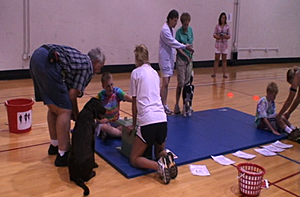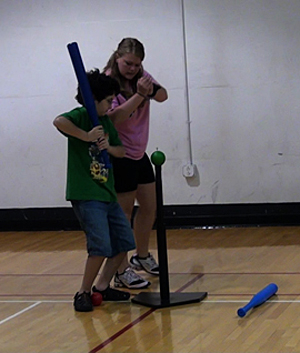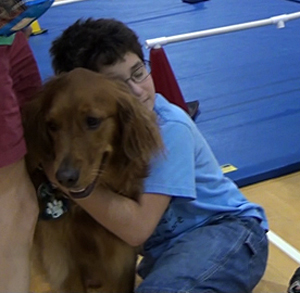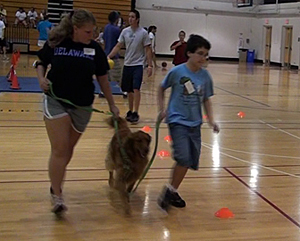
ADVERTISEMENT
- Rozovsky wins prestigious NSF Early Career Award
- UD students meet alumni, experience 'closing bell' at NYSE
- Newark Police seek assistance in identifying suspects in robbery
- Rivlin says bipartisan budget action, stronger budget rules key to reversing debt
- Stink bugs shouldn't pose problem until late summer
- Gao to honor Placido Domingo in Washington performance
- Adopt-A-Highway project keeps Lewes road clean
- WVUD's Radiothon fundraiser runs April 1-10
- W.D. Snodgrass Symposium to honor Pulitzer winner
- New guide helps cancer patients manage symptoms
- UD in the News, March 25, 2011
- For the Record, March 25, 2011
- Public opinion expert discusses world views of U.S. in Global Agenda series
- Congressional delegation, dean laud Center for Community Research and Service program
- Center for Political Communication sets symposium on politics, entertainment
- Students work to raise funds, awareness of domestic violence
- Equestrian team wins regional championship in Western riding
- Markell, Harker stress importance of agriculture to Delaware's economy
- Carol A. Ammon MBA Case Competition winners announced
- Prof presents blood-clotting studies at Gordon Research Conference
- Sexual Assault Awareness Month events, programs announced
- Stay connected with Sea Grant, CEOE e-newsletter
- A message to UD regarding the tragedy in Japan
- More News >>
- March 31-May 14: REP stages Neil Simon's 'The Good Doctor'
- April 2: Newark plans annual 'wine and dine'
- April 5: Expert perspective on U.S. health care
- April 5: Comedian Ace Guillen to visit Scrounge
- April 6, May 4: School of Nursing sponsors research lecture series
- April 6-May 4: Confucius Institute presents Chinese Film Series on Wednesdays
- April 6: IPCC's Pachauri to discuss sustainable development in DENIN Dialogue Series
- April 7: 'WVUDstock' radiothon concert announced
- April 8: English Language Institute presents 'Arts in Translation'
- April 9: Green and Healthy Living Expo planned at The Bob
- April 9: Center for Political Communication to host Onion editor
- April 10: Alumni Easter Egg-stravaganza planned
- April 11: CDS session to focus on visual assistive technologies
- April 12: T.J. Stiles to speak at UDLA annual dinner
- April 15, 16: Annual UD push lawnmower tune-up scheduled
- April 15, 16: Master Players series presents iMusic 4, China Magpie
- April 15, 16: Delaware Symphony, UD chorus to perform Mahler work
- April 18: Former NFL Coach Bill Cowher featured in UD Speaks
- April 21-24: Sesame Street Live brings Elmo and friends to The Bob
- April 30: Save the date for Ag Day 2011 at UD
- April 30: Symposium to consider 'Frontiers at the Chemistry-Biology Interface'
- April 30-May 1: Relay for Life set at Delaware Field House
- May 4: Delaware Membrane Protein Symposium announced
- May 5: Northwestern University's Leon Keer to deliver Kerr lecture
- May 7: Women's volleyball team to host second annual Spring Fling
- Through May 3: SPPA announces speakers for 10th annual lecture series
- Through May 4: Global Agenda sees U.S. through others' eyes; World Bank president to speak
- Through May 4: 'Research on Race, Ethnicity, Culture' topic of series
- Through May 9: Black American Studies announces lecture series
- Through May 11: 'Challenges in Jewish Culture' lecture series announced
- Through May 11: Area Studies research featured in speaker series
- Through June 5: 'Andy Warhol: Behind the Camera' on view in Old College Gallery
- Through July 15: 'Bodyscapes' on view at Mechanical Hall Gallery
- More What's Happening >>
- UD calendar >>
- Middle States evaluation team on campus April 5
- Phipps named HR Liaison of the Quarter
- Senior wins iPad for participating in assessment study
- April 19: Procurement Services schedules information sessions
- UD Bookstore announces spring break hours
- HealthyU Wellness Program encourages employees to 'Step into Spring'
- April 8-29: Faculty roundtable series considers student engagement
- GRE is changing; learn more at April 15 info session
- April 30: UD Evening with Blue Rocks set for employees
- Morris Library to be open 24/7 during final exams
- More Campus FYI >>
2:50 p.m., Aug. 23, 2010----The batter places the ball on the tee, swings, and connects. The fielder snags the ball in the air, returns it to the batter, and trots back to the outfield. The next hit is a grounder, scooped up expertly by the fielder and returned to home plate.
But this is no ordinary baseball game. The batter is a 13-year-old boy with autism spectrum disorder (ASD), and the fielder is a yellow Labrador retriever named Lacey.
The two are participants in a pilot program at the University of Delaware to examine how the presence of therapy dogs in an afterschool physical education program affects activity levels and social behavior in children with ASD.
The project is supported by seed funding from the University of Delaware Research Foundation to an interdisciplinary team of researchers including Iva Obrusnikova, assistant professor in the Department of Behavioral Health and Nutrition (BHAN); Al Cavalier, associate professor in the School of Education; and Janice Bibik, associate professor in BHAN.
The three hope that the study will provide them with enough preliminary data to serve as the basis for a proposal to the National Institutes of Health.
“Obesity is increasingly recognized as a problem in children with ASD,” Obrusnikova says. “They often have oral aversions to certain foods, leading to a limited diet. They also tend to spend less time in physical activity than their non-disabled peers for a variety of reasons, including not only less opportunity but also limited attention span, poor coordination and body awareness, difficulty coping with certain stimuli, and deficits in interpersonal relationships.”
The researchers knew that interventions with trained dogs were being used with a variety of populations to promote psychological, social, and physical benefits. Why not kids with ASD?
Obrusnikova was already directing a program for children with ASD through the Delaware Adapted Sports Club at UD, so she decided to explore the use of therapy dogs with a subset of the club participants. Five children between the ages of nine and fourteen have since been paired with canines through PAWS for People, a Newark-based organization that provides volunteer pet-assisted visitation services in a range of settings. Lynn Robinson, a 1973 graduate of UD, serves as executive director of PAWS.
Twice weekly, the children in the program attend an exercise class on the UD campus, wearing heart rate monitors and accelerometers. With their dogs, they visit eight stations, involving stepping, jogging, shooting baskets, hitting baseballs, jumping hurdles, and completing various flexibility and stretching exercises.
UD students videotape the activities and record accomplishments -- for example, the number of pushups or sit-ups completed or the distance reached at a flexibility station.
Anecdotal evidence is already mounting about the success of the program. Robinson has noted marked improvement in the 12-year-old boy who is partnered with her golden retriever, Calli.
“Before he started working with the dog, his pedometer showed that he walked 1,000 steps,” Robinson said. “With her, he logged 4,000 steps in the next session.”
The boy had little to say about the experience except that Calli is “nice and wonderful and huggable,” but Robinson said that his tendency to leave the activities to go to his mother had decreased significantly.
Lacey's human partner was much more willing to share his thoughts about the activities. “I love working with her,” he said. “She really pumps me up and gets me going.”
Another 12-year-old boy works with a chocolate Lab named Chip. “He's now doing things he couldn't do at all before, and he's doing them well,” said his mother. “He enjoys coming. He doesn't always enjoy the work, but he can see the benefits he gets from it.”
After a brief water break, the pair headed for the hurdles station, with the boy simultaneously protesting about the exercise and smiling at the dog.
“A dog can change things for these kids by serving as a motivator and as a link between the kids themselves,” Obrusnikova said. “A child who might not otherwise talk to another child will be more likely to approach him if he has a dog. The animal breaks the ice.”
One mother whose child had a severe dog phobia watched that fear disappear when the five therapy dogs were brought into the class. “He understood that the dogs were here to help the children,” she said, “and he immediately reached out to pet one of them. He would never have done that before -- he was terrified.”
The class has also provided graduate student Danielle Miccinello and three undergraduate service learning students -- Kyle Manley, Sarah Port, and Darcy Kyle -- with a unique experience.
“It's one thing to read about how children with ASD behave, but it's completely different to actually teach these children and interact with them,” Kyle said. “Being a part of the improvements they make both with and without the dogs is an experience you just can't get in the classroom.”
So far, the parents are pleased, too.
“The college students are very caring and devoted,” said one mother. “They come here week after week because they really care about the kids. It's incredible to watch the children become more social week after week. Here, they can be like anybody else.”
Article by Diane Kukich





